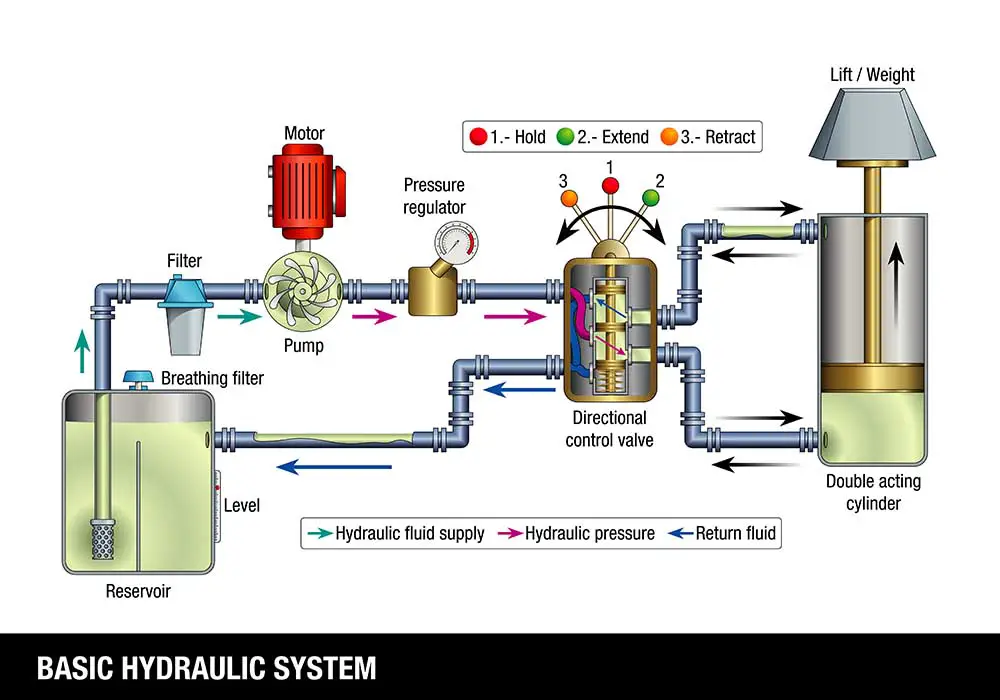Hydraulic systems are incredibly complex and all vary slightly depending on their intended use. Every system must contain 7 different basic components in order to function correctly.
These are a reservoir oil tank, pipes, a hydraulic pump, a power source, an actuator, valves, and filters.
The reservoir oil tank is where the hydraulic oil is stored. This reservoir protects the oil from contaminants which could hinder the functionality of the entire system.
The pipes are a relatively self-explanatory component, used to transfer the hydraulic fluids around the system.

The hydraulic pump is what draws the fluid out of the reservoir and into the rest of the system. This is done by creating a vacuum at the pump inlet. This pushes fluid out of the reservoir and into the pump,
Here it is forced into the pump outlet and around the system.
The power source tends to be an electric motor and is required for mechanical functions. The actuator is used to translate the hydraulic power of the fluid to mechanical power for operation.
The valves dictate the flow rate, direction, and pressure of the fluid around the system. Finally, the filters are used to protect the system against contamination which could cause blockages and damages.
What are the most common causes of hydraulic system failure?
There are 3 common causes of hydraulic system failures.
The first pertains to the hydraulic lines. If they are routed incorrectly then they can be placed under increased stress from movement and vibrations, which can lead to damage.
Another reason the lines may fail is if the pressure traveling through them is too high.
It is estimated that 80% of hydraulic system failures are caused by contaminated hydraulic fluids. If debris enters the hydraulic fluid this then gets circulated around the system.
This can lead to damage and will make the hydraulic system function much less effectively.
The other main issue with hydraulic systems is seal failure. The seals are commonly made from soft and flexible materials like rubber and polyurethane which can easily be damaged by heat and chemicals.
If the seals are compromised, the system cannot function properly and this can cause a more widespread problem.
Why do hydraulics use oil instead of water?
The main reason for this is due to the need for lubrication within the hydraulic systems. There are many moving parts contained within a hydraulic system that rub against each other.
Without lubrication, this would lead to corrosion and premature wear. Oil creates a film on the surface of moving parts which acts as a lubricant during movement.
The temperature within a hydraulic system can get very high, and water does not have a particularly high boiling point. As the water boils it becomes highly compressible, which causes the system as a whole to perform much less effectively.
Not only do hydraulic oils have a higher boiling point, but they also have a lower freezing point. This means that the system can function in a large temperature range.
Water will cause the internal components of the system to rust and corrode in the presence of air. This leads to premature degradation of the system.
How often should you change hydraulic oil?
As a rough guide, you should change the hydraulic oil in your system at least once every 4 – 5 years.
This time period will vary according to the type of vehicle, the climate you live in, your regular driving conditions, the usage of the vehicle, and how regularly the hydraulic systems are maintained.
Your owner’s manual should contain recommendations from the manufacturer about hydraulic oil change intervals for your specific vehicle. This is commonly a good starting point.
You should keep an eye out for indicators that the oil needs changing sooner. This could be a drop in the oil levels or a burnt aroma being emitted.
Check the color of your oil too. It should be clear or transparent. If the color turns brown or red, you should replace the oil prior to the next use.
What happens if you use the wrong hydraulic fluid?
This is a really common mistake concerning hydraulic systems. The fluid is used for many different functions within the system so it is vital you choose the correct one.
If the wrong fluid is used then it can cause the system to break down prematurely and decreases the performance efficiency.
The most important factor to get correct is the viscosity of the fluid used. If this is too high then it will not be an effective lubricant which can cause parts to wear quickly.
This in turn will increase the fluid friction and system power losses. This increases the power consumption of your system and reduces the efficiency.
If the viscosity is too low then the hydraulic pumps and the motor can break long before they should. It can also cause an increased risk of contamination within the system.
How often should a hydraulic filter be changed?
As with hydraulic oil, your vehicle’s manufacturer should give an indication of the filter replacement schedule in the owner’s manual. This tends to be after an arbitrary number of hours of usage.
This is useful if you are clueless about hydraulic systems, but is often not the most accurate measure. If you leave the filters too long it could cause them to become clogged and the efficiency of the system will be reduced.
If you change the filter too soon then you waste money and resources by not using it for the full lifespan.
Alternatively, you can use an element control indicator that measures the drop in pressure across the filter. You should look at the number of bar pressure drops when it is at capacity and take note of this.
If it reaches a critical value, then it is time to replace the filter. For instance, if your filter has a 4 bar pressure drop at capacity and the reading is 3 bar, you need to replace the filter.
